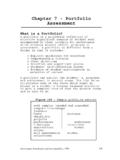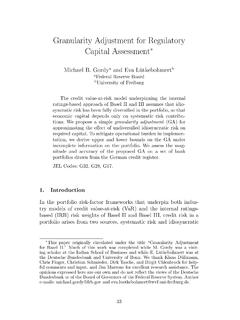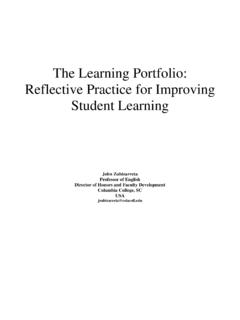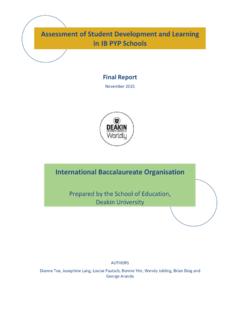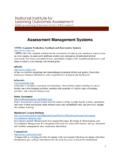Transcription of ePortfolio for Assessment of Learning - FuturEd
1 FuturEd Consulting Education Futurists Inc. Dr. Kathryn Chang Barker, President 101 1001 W. Broadway, pod 190 Vancouver, BC Canada V6H 4E4 phone: 250-539-2139 fax: 250-539-2129 e-mail: website: ePortfolio for the Assessment of Learning FuturEd White Paper Dr. K. Chang Barker: October 2005 1. Introducing the ePortfolio An ePortfolio is an electronic portfolio of acquired Learning knowledge, skills and abilities acquired through formal, non-formal, informal, accidental and incidental Learning . The ePortfolio is currently defined as a collection of authentic and diverse evidence, drawn from a larger archive representing what a person or organization has learned over time on which the person or organization has reflected, and designed for presentation to one or more audiences for a particular rhetorical purpose (National Learning Infrastructure Initiative, 2003).
2 The term ePortfolio , then, is shorthand for two items the digital archive and the presentation drawn from if for different purposes. One of those purposes may be the Assessment of Learning , , Assessment of student achievement by teachers and/or self- Assessment of progress and changes in Knowledge, Skills and Abilities (KSA). The ePortfolio is about both process and product. ePortfolio tools with interventions by teachers or mentors - help creators / users to identify and reflect on the outcomes of Learning experiences. Creators can be individuals, organizations, even businesses eP Assessment of FuturEd : Oct. 2005 and they can be the receivers / processors as well.
3 In the context of adult literacy, the Portfolio has the capacity to be a Learning tool, an Assessment tool, and a record of achievement. It is inherently motivational in that it focuses on what the person can do, rather than what they can t, as measured by standardized tests. In fact, portfolio Assessment and portfolio Learning are common practice in primary literacy education, and in adult literacy and basic education programs. For example, in Cape Breton, adult learners and their tutors use a paper-based process to demonstrate To portfolio Assessment , the ePortfolio adds the electronic dimension that enhances the storage size and updating capabilities of a paper-based portfolio.
4 FuturEd Consulting Education Futurists Inc. has studied and promoted the ePortfolio since 1996. FuturEd research demonstrates that the ePortfolio is linked closely with: Human resources development and Human Capital Management as the means of identifying and managing what a person and a group of persons knows and can do; lifelong Learning as the method of tracking and recognizing ongoing Learning , as an incentive to the lifelong Learning requirement; Prior Learning Assessment as the outcome of the PLA process of exploring and determining an individual s non-formal and informal Learning ; education and training at all levels (K-12, PSE and workplace) - as a teaching tool (reflection as a basis for Learning ), as a Learning management tool ( , project-based Learning ) and as an alternative form of Learning Assessment ; eLearning as a type of Knowledge Management, a part of a Student Information System and a potential form of Usable Learning Object repository; Learning organizations as a means of tracking and developing human capital and assisting professional development of employees within organizations across sectors; community economic development as an inventory of collective community human capital assets.
5 Future Learning systems that rely less on credentials and more on competencies; and 1 Available at Assessment of FuturEd : Oct. 2005 ePortfolio systems of producers and consumers to enhance return on investment for users. This brief paper focuses on one of the important uses of an ePortfolio technology-assisted Assessment of Learning . 2. ePortfolio Assessment of Learning There are various means to assess and record a person s acquired Learning , , test results and report cards in school, performance appraisals at work, personal journals. The ePortfolio may be newest form of recording Learning , but portfolio Assessment has been used for a very long time.
6 Hence, the electronic portfolio can make portfolio Assessment more effective and efficient. ePortfolio Assessment of Learning A ePortfolio provides both evidence of a person s Learning and the individual s reflection of his/her own work. It is a record of Learning , growth and change; and it provides meaningful documentation of individual abilities. An ePortfolio is an ever-evolving organic creation. In the academic environment, examples of types of portfolios include: developmental portfolio: documents a student s improvements in a subject area over a school year; contains samples of the student s work along with self-evaluations of specific assignments; provides documentation which can be used for student evaluations and parent conferences; teacher planning: using an existing portfolio system ( , commercial, on-line) to receive information about an incoming class of students; proficiency portfolio: used as a means for determining graduation/completion eligibility, , requiring students to complete portfolios in certain areas.
7 Showcase portfolio: documents a student s best work accomplished during an entire educational career, , research papers, art work, and science experiments which best represent the student s skills and abilities; employment skills: a student portfolio used by employers to evaluate prospective employee s work readiness skills, , employability skills portfolios created by students in Michigan public skills; and college admission portfolio: a student portfolio, usually a showcase portfolio, used to determine eligibility for admission to college, university. eP Assessment of FuturEd : Oct. 2005 Portfolio Assessment combines many innovations in the appropriate Assessment of Learning , , alternative Assessment , authentic Assessment , competency-based Assessment , flexible Assessment , and standards-based Assessment .
8 Alternative Assessment refers to alternative means of enhancing educational Assessment through, , confidence measurement, analysis of self-awareness, and performance Authentic Assessment involves examining students basic skills, control of information, high level of understanding, personal characteristics, and habits of mind;3 and allows students to participate actively in their own Competency-based Assessment is the Assessment of competence against standards set for knowledge and skills in a particular area, typically used in vocational education and professional certification processes. Flexible Assessment can include checklists, portfolios, performance tasks, product assessments, projects and simulations; observation of the learner, questioning, oral or written tests and essays, projects undertaken in groups or individually, role playing, work samples, computer-based Assessment ; and flexible Assessment is intended to suit the learner s pace and style of Learning and assess the individual when s/he is ready.
9 Standards-based Assessment is intended to measure achievements against stated Learning outcomes or objectives. Combining elements of all these, portfolio Assessment involves using the products in a portfolio as the evidence of Learning for Assessment purposes. Portfolio approaches to literacy Assessment have been used throughout the 1990s, and they are relatively A literacy portfolio is a systematic collection of a variety of teacher observations and student products, collected over time, that reflect a student s developmental status and progress made in literacy. In some cases, teachers 2 Improving Educational Assessment by Incorporating Confidence Measurement, Analysis of Self-Awareness, and Performance Evaluation: The Computer-based Alternative Assessment Project (Paul, 1998) at Portfolio Assessment and the New Paradigm: New Instruments and New Places (Engel, 1994) on the ERIC website at ~eric_rec/ieo/ Becoming Reflective Students and Teachers with Portfolios and Authentic Assessment (Paris and Ayres, 1994) on the ERIC web site at ~eric_rec/ieo/ See, for example, Portfolio Assessment at Assessment of FuturEd : Oct.
10 2005 are expected to set standards or expectations in order to then determine a student s developmental level in relation to those standards. Portfolio Assessment , as it has developed in the literacy field, is considered to be a promising approach to validity in Assessment : consequences, fairness, transfer and generalizability, cognitive complexity, content quality, content coverage, meaningfulness and cost efficiency. Types of portfolios used for academic Assessment purposes include, , the reflection portfolio, literacy portfolio, process portfolio, student reading portfolio, showcase portfolio, exit In the educational environment, uses of portfolio Assessment include: 1. in pre-service teacher training, to open the way for students to construct alternative conceptions of teaching,7 to think reflectively about experiences in a community service- Learning program,8 to bridge personal and professional funds of knowledge; 9 2.
